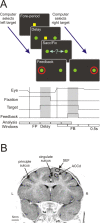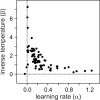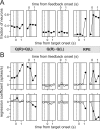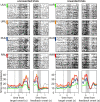Temporal filtering of reward signals in the dorsal anterior cingulate cortex during a mixed-strategy game
- PMID: 17670983
- PMCID: PMC2413179
- DOI: 10.1523/JNEUROSCI.2369-07.2007
Temporal filtering of reward signals in the dorsal anterior cingulate cortex during a mixed-strategy game
Abstract
The process of decision making in humans and other animals is adaptive and can be tuned through experience so as to optimize the outcomes of their choices in a dynamic environment. Previous studies have demonstrated that the anterior cingulate cortex plays an important role in updating the animal's behavioral strategies when the action outcome contingencies change. Moreover, neurons in the anterior cingulate cortex often encode the signals related to expected or actual reward. We investigated whether reward-related activity in the anterior cingulate cortex is affected by the animal's previous reward history. This was tested in rhesus monkeys trained to make binary choices in a computer-simulated competitive zero-sum game. The animal's choice behavior was relatively close to the optimal strategy but also revealed small systematic biases that are consistent with the use of a reinforcement learning algorithm. In addition, the activity of neurons in the dorsal anterior cingulate cortex that was related to the reward received by the animal in a given trial often was modulated by the rewards in the previous trials. Some of these neurons encoded the rate of rewards in previous trials, whereas others displayed activity modulations more closely related to the reward prediction errors. In contrast, signals related to the animal's choices were represented only weakly in this cortical area. These results suggest that neurons in the dorsal anterior cingulate cortex might be involved in the subjective evaluation of choice outcomes based on the animal's reward history.
Figures













References
-
- Aston-Jones G, Cohen JD. An integrative theory of locus coeruleus-norepinephrine function: adaptive gain and optimal performance. Annu Rev Neurosci. 2005;28:403–450. - PubMed
-
- Barraclough DJ, Conroy ML, Lee D. Prefrontal cortex and decision making in a mixed-strategy game. Nat Neurosci. 2004;7:404–410. - PubMed
Publication types
MeSH terms
Grants and funding
LinkOut - more resources
Full Text Sources
